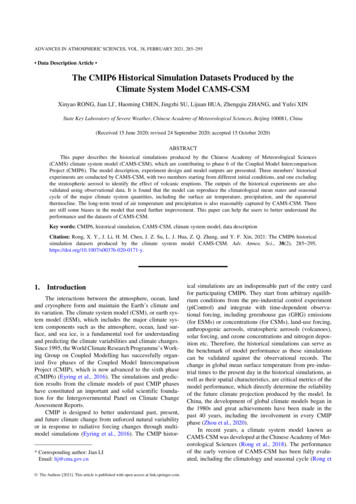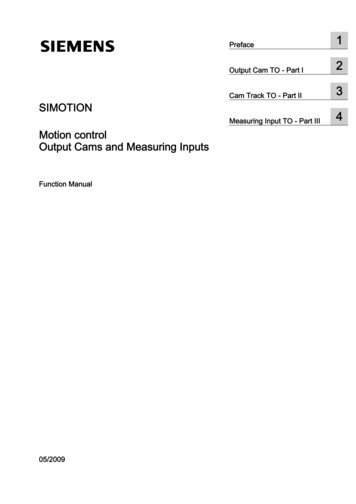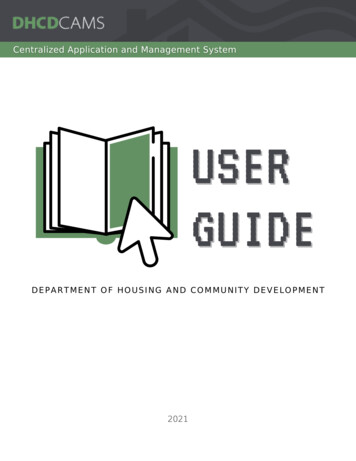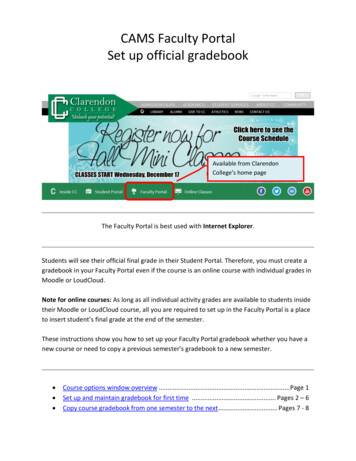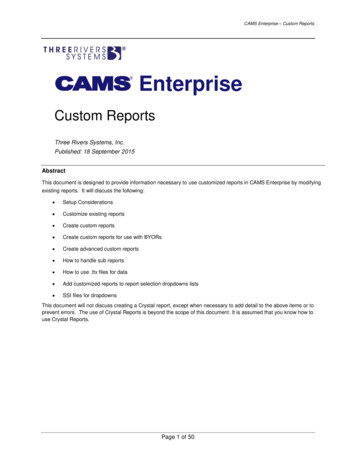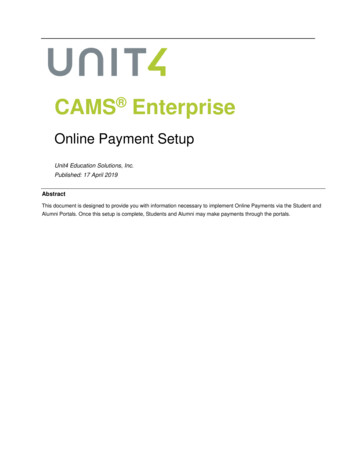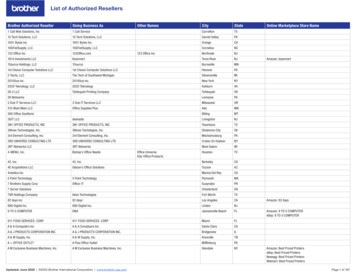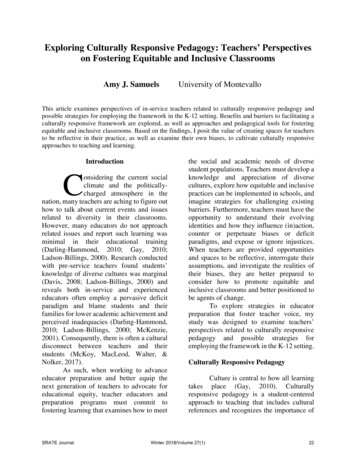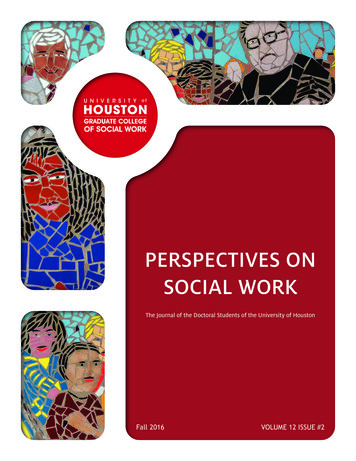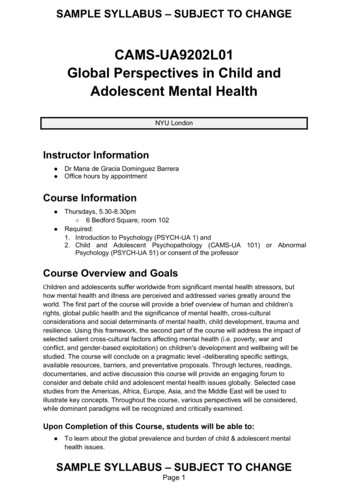
Transcription
SAMPLE SYLLABUS – SUBJECT TO CHANGECAMS-UA9202L01Global Perspectives in Child andAdolescent Mental HealthNYU LondonInstructor Information Dr Maria de Gracia Dominguez BarreraOffice hours by appointmentCourse Information Thursdays, 5.30-8.30pm 6 Bedford Square, room 102Required:1. Introduction to Psychology (PSYCH-UA 1) and2. Child and Adolescent Psychopathology (CAMS-UA 101) or AbnormalPsychology (PSYCH-UA 51) or consent of the professorCourse Overview and GoalsChildren and adolescents suffer worldwide from significant mental health stressors, buthow mental health and illness are perceived and addressed varies greatly around theworld. The first part of the course will provide a brief overview of human and children’srights, global public health and the significance of mental health, cross-culturalconsiderations and social determinants of mental health, child development, trauma andresilience. Using this framework, the second part of the course will address the impact ofselected salient cross-cultural factors affecting mental health (i.e. poverty, war andconflict, and gender-based exploitation) on children's development and wellbeing will bestudied. The course will conclude on a pragmatic level -deliberating specific settings,available resources, barriers, and preventative proposals. Through lectures, readings,documentaries, and active discussion this course will provide an engaging forum toconsider and debate child and adolescent mental health issues globally. Selected casestudies from the Americas, Africa, Europe, Asia, and the Middle East will be used toillustrate key concepts. Throughout the course, various perspectives will be considered,while dominant paradigms will be recognized and critically examined.Upon Completion of this Course, students will be able to: To learn about the global prevalence and burden of child & adolescent mentalhealth issues.SAMPLE SYLLABUS – SUBJECT TO CHANGEPage 1
SAMPLE SYLLABUS – SUBJECT TO CHANGE To appreciate the diverse contexts in which children live around the world andtheir unique vulnerability when facing extreme challenges.To develop a sensitivity to various cultural perspectives of mental health andillness.To critically examine social determinants of children’s mental health, global trends,resources and barriers to change.To be able to prepare a scientific poster ready for submission for a scientificconferenceCourse RequirementsGrading of AssignmentsThe grade for this course will be determined according to these assessment components:Assignments/ActivitiesClass PreparationMidterm ProjectGroup oralpresentationFinal ProjectDescription of AssignmentIncludes class assignments, reflecting agood understanding or critical thinking ofthe reading and region reports.Based on individual areas of interest,students will choose a topic and setting tofurther explore. It will include backgroundresearch of the topic and an analysis onthe impact on children’s rights,development and mental health based onlectures and previously assigned material.Students will submit a poster with anabstract (500 words).Students will work in groups on selectedcase studies from the Americas, Africa,Europe, Asia and the Middle East and willdeliver a group presentation (10 min)Based on the topic selected for midtermexam, the student will present the finalproject as a poster with an abstract havingintegrated the feedback from the midtermexam and expanded the topic selected onpossible approaches to addressing theissue. The final poster will be presentedduring the final sessions for peer teaching,discussion, and feedback prior tosubmission. The final submission willinclude the poster and its abstract (500words).% ofFinalGradeDue30%Week 1-1220%Week 620%Week 1230%Week 15Failure to submit or fulfill any required course component results in failure of the classSAMPLE SYLLABUS – SUBJECT TO CHANGEPage 2
SAMPLE SYLLABUS – SUBJECT TO CHANGEGradesLetter grades for the entire course will be assigned as follows:LetterGradePercentAExample: 93.5% and higherBExample: 82.5% - 87.49%CExample: 72.5% - 77.49%DExample: 62.5% - 67.49FExample: 59.99% and lowerCourse MaterialsDescriptionExtraordinary. Consistent and superiorpreparation by completing assigned readings,submitting considered and insightfulassignments, and updating region reports; aswell as active participation in each discussion.Excellent oral presentation skills. Outstandinganalysis of the selected topic as reflected in midterm project and final project.Very good, above average. Regular preparationby completing assigned readings, submittingconsidered assignments, and updating regionreports; as well as active participation in themajority of discussions. Very good oralpresentation skills. Thoughtful analysis of theselected topic as reflected in mid-term projectand final project.Average. Usual preparation for class withoccasional failure to complete assigned readings,submit discussion questions, or update regionreports; but general attentiveness andparticipation in most of the classes. Average oralpresentation skills. Completion of analysis of theselected topic in mid-term project and finalproject.Below average. Irregular preparation for class,e.g. failure to complete assigned readings,submit discussion questions, or update regionreports; lack of attentiveness and participationin most of the classes. Poor oral presentationskills. Poorly developed analysis of the selectedtopic as reflected in midterm project and finalproject.Fail. Multiple unexcused absences orunapproved extensions, failure to submit themidterm or final project, very poorpresentations skills or level of work far belowexpected standards.Required Textbooks & Materials A Long Way Gone: Memoirs of a Boy Soldier by Ishmael Beah. ISBN-10:0374531269, ISBN-13: 978-0374531263Girls Like Us: Fighting for a World Where Girls Are Not for Sale: A Memoir byRachel Lloyd. ISBN-10: 0061582069, ISBN-13: 978-0061582066SAMPLE SYLLABUS – SUBJECT TO CHANGEPage 3
SAMPLE SYLLABUS – SUBJECT TO CHANGEOptional Textbooks & Materials See papers selected for each session (below)Resources Access your course materials: NYU Classes (nyu.edu/its/classes)Databases, journal articles, and more: Bobst Library (library.nyu.edu)NYUL Library Collection: Senate House e with strengthening your writing: NYU Writing Center(nyu.mywconline.com)Obtain 24/7 technology assistance: IT Help Desk (nyu.edu/it/servicedesk)Course ScheduleSession/DateTopicReadingAssignmentDuePART ISession 1:Introduction(Overview ofcourse &introduction tohuman rightsframework)Session 2:Global publichealth:significance ofmental healthSession 3:Cross-culturalconsiderations& socialdeterminants ofmental healthSession 4:ChilddevelopmentSession 5:Trauma &resilienceBelfer & Song (2012). The United Nations Conventionon the Rights of the Child and Implications forClinical Practice, Policy and Research. In Rey JM(Ed), IACAPAP e-Textbook of Child and AdolescentMental Health. Geneva: International Associationfor Child and Adolescent Psychiatry and AlliedProfessions.On-line interview by Earls, Child as CitizenSeven Up - Michael Apted, 1964 to 2012, UK (1st film)Patel (2006). Beyond Evidence: The Moral Case forInternational Mental Health. Am J Psychiatry 163:8.Summerfield, D. (2012). Afterword: Against “globalmental health”. Transcultural Psychiatry 49(3):1-12.Seven Up - Michael Apted, 1964 to 2012, UK (2nd film)Fadiman, A. (1997). The Spirit Catches You & You FallDown: a Hmong child, her American doctors, and thecollision of two cultures. New York: Farrar, Straus,and Giroux. (selected chapters)Chung et al, (2016). Screening for social determinantsof health among children and families living inpoverty: A guide for clinicians. Curr Probl PediatrAdolesc Health Care, 46:135-153.Persepolis – Marjane Satrapi, 2008, Iran/ViennaNational Scientific Council on the Developing Child.(2004). Young children develop in an environment ofrelationships. Working Paper No. 1. Retrieved fromhttp://www.developingchild.netSteinberg, L. (2009). Should the science of adolescentbrain development inform public policy? AmericanPsychologist 64(8),739-750.The Boys of Baraka - Rachel Grady & Heidi Ewing,2005, USA/KenyaStein et al. (2007). Post-Traumatic stress disorder:medicine and politics. Lancet, 369: 139-144.Gilles, Taylor, Gray, O’Brien and D’Abrew. (2013).Psychological therapies for the treatment of post-Region reports(presentation ofregion)Region reports(cross-culturalconsiderations)Think topics ofinterest formid-term &final projectRegion reports(childdevelopment)Region reports(child trauma)SAMPLE SYLLABUS – SUBJECT TO CHANGEPage 4
SAMPLE SYLLABUS – SUBJECT TO CHANGESession/DateSession 6:TopicTrauma &resiliencePART IISession 7:Poverty &structuralviolenceSession 8:War & conflictSession 9:Gender-basedexploitationSession 10:GlobalOrganizationsbreakSession 11:Internationalhumanitariananddevelopmentwork &Perspectives:commonalities& differencesReadingtraumatic stress disorder in children andadolescents (Review). Evid.-Based Child Health8:3:1004-116.Seven Up - Michael Apted, 1964 to 2012, UK (3rd film)Happer et al. Children’s resilience and traumaspecific cognitive behavioural therapy: comparingresilience as an outcome, a trait and a process.Child Abuse Neglect 73 (2017) 30-41.Walker et al. (2011). Inequality in early childhood:risk and protective factors in early childdevelopment. The Lancet 378(9799): 1325-1338.Costello et al (2009). Relationships between povertyand psychopathology. JAMA 15, vol 290 (15), 20232029.Grantham et al. (2007). Developmental potential inthe first 5 years for children in developingcountries. The Lancet 369(9555): 60-70.Skin - Anthony Fabian, 2008, South AfricaWar Child (channel 4 – via app)Slone & Mann (2016). Effects of War, Terrorism andArmed Conflict on Young Children: A SystematicReview. Child Psychiatry Hum Dev 47: 950-965.Frounfelker, R. L., Assefa, M. T., Smith, E., Hussein, A.& Betancourt, T. S. (2017). "We would never forgetwho we are": resettlement, cultural negotiation,and family relationships among Somali Banturefugees. Eur Child Adolesc Psychiatry. May 4. doi:10.1007/s00787-017-0991-1.Children Underground - Edet Belzberg, 2002, RomaniaBruce, J. (2016). The difficulties of “living while girl”. JVirus Erad 2(3): 177-82.Jimenez-Ruiz & Almansa-Martinez (2016). Femalegenital mutilation and transcultural nursing:adaptation of the Rising Sun Model. ContemporaryNurse, doi:10.1080/10376178.2016.1261000God grew tired of us - 2006, Sudan/USShivji, I.G. (2007). Silences in NGO Discourse: The roleand future of NGOs in Africa. Oxford: Fahamu.(selected chapters)Harper & Cetin (2008). Child and Adolescent MentalHealth Policy: promise to provision. Int RevPsychiatry 20(3): 217-24.Babies - Thomas Balmès, 2010, Namibia, Mongolia,Japan, & U.S.Engle et al. (2011). Strategies for reducinginequalities and improving developmentaloutcomes for young children in low-income andmiddle-income countries. Lancet 378(9801): 133953.Kieling et al. (2011). Child and adolescent mentalhealth worldwide: evidence for action. Lancet378(9801): 1515-25.AssignmentDueRegion reports(child resilience)Mid-termprojectsubmission(poster &abstract)Region reports(war & conflict)Region reports(gender-basedexploitation)Region ianwork)Region Reports– GroupPresentationsSAMPLE SYLLABUS – SUBJECT TO CHANGEPage 5
SAMPLE SYLLABUS – SUBJECT TO CHANGESession/DateTopicReadingSession 12:Final project –students’ presentations & discussionsSession 13:Co-CurriculartripVisit to the Mildred Creak Unit (Child andAdolescent Mental Health Inpatient Unit), GreatOrmond Street Hospital for Children, LondonSession 14:Final project –students’ presentations & discussionsFinalAssessment:Final projectpresentation &submissionAssignmentDue--Final projectsubmission(poster &abstract)Co-Curricular Activities Visit to the Mildred Creak Unit (Child and Adolescent Mental Health Inpatient Unit),Great Ormond Street Hospital for Children, London (UK). The Mildred Creak Unitis a highly specialized ward for children aged seven to 15 with mental healthproblems. The special areas of expertise include: somatising disorders, eatingdisorders and mood disorders. The unit offers a therapeutic environment with astructured programme. This structure creates a safe framework for individual,family and group work. This unit is based at Great Ormond Street Hospital(GOSH), an international centre of excellence in child healthcare. – Pending toconfirm agreement from NYUL, unit availability and NYUL students availability ondate/time.Classroom Etiquette Classes start at 5.30pm. Please be on time.NYUL Academic PoliciesAttendance and Tardiness Key information on NYU London’s absence policy, how to report absences, andwhat kinds of absences can be excused can be found on our ance-policy.html)Assignments, Plagiarism, and Late Work You can find details on these topics and more on this section of our NYUL mic-policies.html) and on thePolicies and Procedures section of the NYU website for students studying away atglobal sites m ConductSAMPLE SYLLABUS – SUBJECT TO CHANGEPage 6
SAMPLE SYLLABUS – SUBJECT TO CHANGEAcademic communities exist to facilitate the process of acquiring and exchangingknowledge and understanding, to enhance the personal and intellectual development ofits members, and to advance the interests of society. Essential to this mission is that allmembers of the University Community are safe and free to engage in a civil process ofteaching and learning through their experiences both inside and outside the classroom.Accordingly, no student should engage in any form of behaviour that interferes with theacademic or educational process, compromises the personal safety or well-being ofanother, or disrupts the administration of University programs or services. Please refer tothe NYU Disruptive Student Behavior Policy for examples of disruptive behavior andguidelines for response and enforcement.Disability Disclosure StatementAcademic accommodations are available for students with disabilities. Please contact theMoses Center for Students with Disabilities (212-998-4980 or mosescsd@nyu.edu) forfurther information. Students who are requesting academic accommodations are advisedto reach out to the Moses Center as early as possible in the semester for assistance.Instructor BioMaria de Gracia Dominguez Barrera, MD. PhD, graduated in Medicine, completed herspecialist clinical training in psychiatry and began her academic career in Neuroscience(University of the Basque Country) in Spain. In 2006, Dr. Dominguez obtained a MarieCurie Fellowship and moved to Maastricht University (Netherlands), where she developedher research interest in psychiatric epidemiology studying environmental and socialdeterminants of psychosis in adolescence. After obtaining her PhD 'A Dynamic Model ofthe Onset of Clinical Psychosis from an Epidemiological Perspective', she continued towork as a postdoctoral researcher at Maastricht University. In 2010, Dr. Dominguezobtained an Alicia Koplowitz Fellowship (clinical and research fellowship in Child &Adolescent Psychiatry) at Imperial College London (UK), where she worked as ClinicalLecturer and continued her research work in adolescent clinical psychosis. In 2012, Dr.Dominguez completed PGCert in University Learning and Teaching at Imperial College(2012 Rees Rawling Price). In 2014, Dr. Dominguez completed the PGDip at AppliedSystemic Theory/ Therapy at the Tavistock Centre (University of East London). In 2016,she completed her CCT in Child and Adolescent Psychiatry. Dr Dominguez currentlyworks as Consultant Child and Adolescent Psychiatrist, Clinical Lead of theNeurodevelopmental Service at Ealing CAMHS (West London NHS Trust) and honoraryClinical Senior Lecturer at Imperial College London. Dr. Dominguez was awarded theEuropean Psychiatry Association research prize in child and adolescent psychiatry in2014. Since 2014, she has been the president of the Association of Scientists in Child andAdolescent Mental Health – Alicia Koplowitz Foundation.SAMPLE SYLLABUS – SUBJECT TO CHANGEPage 7
The Spirit Catches You & You Fall Down: a Hmong child, her American doctors, and the collision of two cultures. New York: Farrar, Straus, and Giroux. (selected chapters) Chung et al, (2016). Screening for social determinants of health among children and families living in poverty: A guide for clinicians. Curr Probl Pediatr
